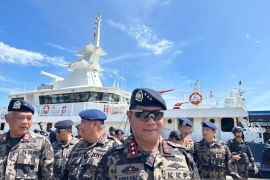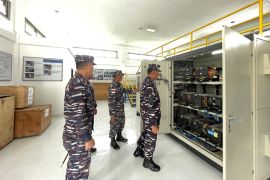Geographically, Natuna's remote position comes with both strategic advantages and pressing challenges. Although the district lies along an international shipping route, it faces persistent obstacles in sustaining the lives of its residents.
Natuna is far removed from Tanjung Pinang, the capital of the Riau Islands. Despite being part of the same province, the two regions are separated by up to two days of sailing. In addition, the district has long been heavily dependent on supplies from other regions for food, including rice.
Due to high production costs coupled with limited guidance, land, and agricultural technology, the volume of rice produced locally in Natuna remains minuscule compared to the district's annual need of around 5,800 tons. In short, rice farmers’ productivity has remained at an unfavorable rate.
That trend, however, is seemingly nearing its end, with Natuna recording significant increases in rice yields over the last two years. This progress rekindles hope for self-sufficiency in food, a goal that forms part of President Prabowo Subianto’s broader national agenda.
Raking up production
Of Natuna's 414 hectares of agricultural land, 342.63 hectares were declared as sustainable agricultural fields under a local regulation in 2024, serving as a legal basis to discourage the conversion of such land into sites for other purposes.
The Natuna Office of Food Security and Agriculture (KPP) reported that the district’s rice output rose by 53.82 percent, from 113.68 tons last year to 174.86 tons as of October 2025. The figure is projected to reach 200 tons by the end of this year, with one harvest period remaining.
KPP Head Wan Syazali affirmed that the production hike is solid proof that Natuna holds real potential in the agricultural sector. He said that consistency and concrete, continuous support are necessary for the district to unlock its full potential.
While still far from achieving self-sufficiency, Natuna has moved one step closer with this progress—the result of stronger collaboration between the local and central governments in guiding farmers to harness idle land and adopt modern agricultural practices.
Recognizing Natuna’s strategic position for Indonesia, the central government recently distributed 78.6 tons of subsidized fertilizers consisting of urea and another type made of nitrogen, phosphorus, and potassium (NPK).
To complement the distribution, the Natuna government delivered 36 tons of NPK fertilizers and 44.05 tons of dolomite lime free of charge to farmers in the first week of November 2025.
A pillar of sovereignty
Natuna’s agricultural growth holds significance not only for the district’s food security but also for national interests. As a border region for Indonesia, this region reserves the right to adequate access to food. Therefore, Indonesia’s image, to some extent, depends on Natuna’s welfare. In the face of ever-evolving global challenges, it is critical for Indonesia to ensure that all regions have the capacity to independently meet their food needs.
One may confidently argue that the current rice production rate, despite the notable rise in output, is still far from ideal compared to Natuna’s annual need of 5,800 tons of rice. However, it would be unfair to overlook the district’s evident gradual transition toward a more effective approach to agricultural growth.
Natuna is on the right track toward food self-sufficiency. This tiny, remote, archipelagic region has refused to stand idle and drown in reliance on food supplied from outside.
The district is currently planting for the future—one in which its residents are able to feed on rice grown from the very soil of their hometown and to reaffirm Indonesia’s sovereignty from its northern frontier.
From Jakarta to Natuna
Driven by his determination to guide Indonesia in retaining food self-sufficiency, which was achieved during the era of Second President Soeharto, President Prabowo introduced a policy mandating a 20 percent reduction in the prices of subsidized fertilizers.
This executive move reflects the central government’s commitment to siding with farmers, including those producing food in Indonesia’s outermost regions. For farmers in Natuna, the price cut came as a breath of fresh air, easing financial hurdles in production.
As a result, the price of subsidized urea fertilizer dropped from Rp2,250 to Rp1,800 per kg, reducing the price per 50-kilogram sack from Rp112,500 to Rp90,000 (US$5.39). Meanwhile, NPK fertilizer saw a decline from Rp2,300 to Rp1,840 per kilogram, lowering the 50-kilogram sack price from Rp115,000 to Rp92,000 (US$5.50).
Agriculture Minister Andi Amran Sulaiman explained that the policy is designed to ensure orderly distribution, stabilize stocks, and improve farmers’ welfare and productivity, ultimately bringing Indonesia closer to food self-sufficiency.
Moreover, he said the government simplified the redemption process, allowing farmers to bring only their ID cards for verification and photo documentation, eliminating the need for the previously required farmer cards.
As an enforcement measure, the minister warned that the government will not hesitate to take stern action against non-compliant fertilizer retailers and distributors, with around 190 whose business permits have been permanently revoked. He even cautioned regional managers of state-owned fertilizer company Pupuk Indonesia with removal in case of negligence in monitoring.
Yandika Dwi Reginata, a representative from Pupuk Indonesia’s Riau Islands branch, confirmed that the price reduction was implemented since October 22. He assured that fertilizers distributed after that date with the old pricing will be subject to adjustment, meaning farmers will receive compensation based on the price gap.
As Natuna rises to fully harness its agricultural potential, the central and local governments are moving to provide aid and guidance. Complemented by its strategic geographic position, both nationally and internationally, the district holds all it needs to thrive, ensure its residents prosper, and contribute to President Prabowo’s food security drive.
Related news: Gov't establishes modern fish market in Natuna
Related news: Natuna LPSDP saves hundreds of turtle eggs on RI's outermost island
Editor: Arie Novarina
Copyright © ANTARA 2025








